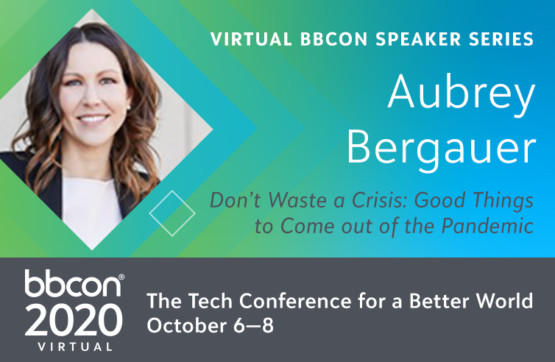Predictions for a Post-Pandemic Future for Arts & Cultural Organizations

As we head into the final months of 2020, some parts of the country are opening up more than others, consumers are itching to get out of their homes, and arts and culture organizations are at a pivotal moment in planning for their comeback.
We asked arts administrator and consultant Aubrey Bergauer to make a few predictions on what this will look like for arts organizations, their marketing efforts, patron engagement, and internal structure and processes.
Q: As sales and marketing restart, what do you expect will be the major changes?
A: I think there will be two big changes on the marketing and sales side. The first is to expect smaller in person audiences. This is because of safety reasons (i.e. socially distancing in our venues might prevent us from selling at capacity) as well as because demand might be down (i.e. we’ve lost momentum in the marketplace and/or people may be skittish about crowds for some time).
The good news is that we can leverage this because the supply/demand curve was already out of balance before the pandemic, meaning the supply of tickets far outstripped the demand for them. The laws of economics say that having less ticket supply available will actually rebalance the equation, or even create demand because the supply of seats will be more limited. Manufacturing demand and managing the perception of demand is what marketing and sales is all about. In other words, if we are either offering fewer performances or fewer tickets available, and combine that with pent up demand from our most loyal patrons, we could potentially manage a return to our concert halls or galleries that sells out—and that would be the best thing possible for our business. It sets us up in a place to keeping building momentum, adding, and growing as we continue to move forward.
The second change we’ll see, or at least a change I encourage, is a hybrid model of in person product and streaming product. Even before the pandemic, research showed that 70% of live streaming participants were more likely to attend a future live concert after participating in the experience online, compared to only 8% who went to a live performance as a means to discover music for the first time (source: Eventbrite). This was already playing out across mainstream genres (i.e. the digital streams via outlets such as Spotify, YouTube, and Facebook were building fans that in turn couldn’t wait to see the artist live), and the pandemic pushed forward the performing arts to think this way too. We now collectively are engaging with our audience digitally in a way we never were before, and to combine that with in-person offerings will create a freemium model: patrons can discover us online and hear our product for low or no cost, and then choose to invest their money in a ticket purchase to come see us in person. We’re building fans before they ever set foot in our venue. Organizations that embrace this strategy will create a gateway to increase sales as they rebuild.
Q: How do you expect the market changes to affect you and your team?
A: So many changes! In my consulting, I’m getting more and more calls asking how to restructure our staffs and teams differently as we rebuild. This is very exciting because now is the time—when so many employees are furloughed or laid off—for organizations to strategize how to bring employees back when the time comes. The same old roles and responsibilities are not what’s needed in a post-pandemic world, so the leaders and organizations that are thinking now how their org structure needs to look different will rebuild smarter and faster.
Another change is for one of my big projects, launching the Center for Innovative Leadership, which was originally planned to debut in 2021. Like so many in-person programs, that’s now on hold. So I’m thinking through if and how I can deliver more virtual programming on my own via my consulting business to offer the training our field needs. Can I serve more people this way? Are there other projects entirely that are more relevant right now?
I’ve also been asked to do a lot of speaking engagements on how not to waste this crisis (my session at this year’s bbcon!) and instead find opportunities in it to do things differently. Whereas before the pandemic I was often asked to speak on growing our audience and brand, now it’s much more about how to do the work internally with the smaller teams we have in place. I love it, because the organizations that bring me in for this know that we can absolutely use this time to raise money, engage with our patrons, and plan for a future that looks different than the world we came from. It’s so forward-facing and exciting.
Q: What process changes have you made during this time in order to be ready for 2021?
A: There are two main areas of process that have been a focus. For years, I’ve been championing putting the customer at the center of what we do, meaning all our organizational strategies, teams, and org chart should be built around that. Few organizations thought and acted that way. But now, so many organizations believe this is the way forward, because the pandemic has made this truth more evident: when we keep the people we serve at the core of what we do, they are the lifeblood that keeps us going, literally in terms of funding our work.
This mindset trickles down to process big time. For example, the process for engaging a patron has changed because not having ticket sales means we’ve had to figure out how to capture information a different way (i.e. give your email address to watch this stream), and then follow up with them very intentionally. The same is true for the process by which we engage with our donors. A pre-concert reception crowd is no longer feasible as another example, and some organizations have gotten very creative with what a virtual connection or event looks and feels like. All of these types of deliberate, diligent, focused strategies I talk about in my Long Haul Model, and now those changes in process have come to the forefront for a lot of institutions.
The other main area for change in process and tools is for remote work. Every single one of us has been on this journey on moving our lives and work to an online, remote format. That’s huge. And I’ve been thinking so much about what this means for the future of our work, specifically how remote capabilities can serve us well post-pandemic. As entertainment organizations, we don’t need all our employees in the office when we return to business. Yes, we all have roles that do require an onsite presence: artists and the operations and production personnel that make those live events happen. But that’s far from everyone, and those roles aren’t required on site every day. This shift opens things up for how we recruit employees, the freedom and autonomy it allows employers to offer in order to retain great talent, and it saves money on the books, too, when we don’t have to pay for the same office space since not everyone is there all the time.
All of these changes herein—from the revolutions in marketing, to the way our teams are structured, to intentionally focusing on our customers, to the way our processes to do work have evolved—make me believe that we absolutely do have a way forward as arts and cultural organizations. Business will not look the same as before, and that’s not a bad thing. We have a future that’s ours to craft.
Join Aubrey Bergauer for her bbcon session “Don’t Waste a Crisis: Good Things to Come out of the Pandemic” to learn how we can use this inflection point to ensure that we build a future for our organization and sector that’s stronger than we ever were before. Register today!

